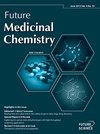一类新型强效抗血管生成和抗氧化吡唑:合成、生物活性、对接和 ADMET 研究。
IF 3.2
4区 医学
Q3 CHEMISTRY, MEDICINAL
引用次数: 0
摘要
目的:血管生成是由血管内皮生长因子/血管内皮生长因子受体-2 信号通路驱动的癌症进展的标志:使用精氨酸和二溴酮合成了一类新型吡唑。抗血管生成活性采用体内卵黄囊法检测。通过羟基和超氧自由基清除试验评估了抗氧化活性。进行了对接研究,以确定吡唑与 VEGFR-2 受体和血管内皮生长因子酪氨酸激酶的结合潜力。使用 SwissADME 和 admetSAR 计算了药物相似性的 ADMET 特性:结果:化合物 5a-e 显示出明显的抗血管生成作用。化合物 5f 显示出有效的羟自由基和超氧自由基清除活性。Docking 结果证实,化合物与 VEGFR-2 受体的潜在结合效率高于 VEGF 酪氨酸激酶,因此可作为竞争性抑制剂发挥作用。ADMET 研究表明,这些化合物具有良好的类药物特性:本研究提出了一类新型吡唑,作为抗氧化剂和抗血管生成剂具有良好的药物相似性。本文章由计算机程序翻译,如有差异,请以英文原文为准。
A novel class of potent antiangiogenic and antioxidant pyrazoles: synthesis, bioactivity, docking and ADMET studies.
Aim: Angiogenesis is the hallmark of cancer progression driven by VEGF/VEGFR-2 signalling pathway, inhibition of which could be a solution to tackle the progression of tumour cells and thus arresting their growth.Materials & methods: A novel class of pyrazoles was synthesized using arginine and dibromo ketones. Antiangiogenic activity was performed by in vivo yolk sac method. Antioxidant activity was evaluated by hydroxyl and superoxide radical scavenging assays. Docking studies were performed to determine the pyrazoles' binding potential with VEGFR-2 receptor and VEGF tyrosine kinase. ADMET properties were calculated using SwissADME and admetSAR for drug-likeness.Results: Compounds 5a-e showed significant antiangiogenic effects. Compound 5f exhibited effective hydroxyl and superoxide radical scavenging activities. Docking results confirmed the potential binding efficiency with VEGFR-2 receptor over VEGF tyrosine kinase, thus, functioning as competitive-inhibitors. ADMET studies revealed that the compounds possess favourable drug-like qualities.Conclusion: This study presents a novel class of pyrazoles as promising antioxidant and antiangiogenic agents with favourable drug-likeness properties.
求助全文
通过发布文献求助,成功后即可免费获取论文全文。
去求助
来源期刊

Future medicinal chemistry
CHEMISTRY, MEDICINAL-
CiteScore
5.80
自引率
2.40%
发文量
118
审稿时长
4-8 weeks
期刊介绍:
Future Medicinal Chemistry offers a forum for the rapid publication of original research and critical reviews of the latest milestones in the field. Strong emphasis is placed on ensuring that the journal stimulates awareness of issues that are anticipated to play an increasingly central role in influencing the future direction of pharmaceutical chemistry. Where relevant, contributions are also actively encouraged on areas as diverse as biotechnology, enzymology, green chemistry, genomics, immunology, materials science, neglected diseases and orphan drugs, pharmacogenomics, proteomics and toxicology.
 求助内容:
求助内容: 应助结果提醒方式:
应助结果提醒方式:


